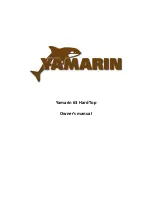
Operation
95
Boarding from the water
WARNING
To avoid severe injury or death, do not
board from the rear, use swim platform, or
swim behind boat if engine is running.
●
Severe internal injuries can occur if wa-
ter is forced into body cavities as a re-
sult of being near the jet thrust nozzle.
●
Exhaust gases coming from underneath
the swim platform contain carbon mon-
oxide, a colorless, odorless gas which
may cause brain damage or death when
inhaled. Symptoms include nausea, diz-
ziness, and drowsiness.
(1) Be sure the engine is off, and then move
to the stern of the boat.
(2) Pull out the ladder and climb up onto the
swim platform. (See page 66 for informa-
tion on ladder.)
(3) Return the ladder to the stowed position,
and then sit in one of the seats provided.
Boarding from a dock or landing jetty
(1) Board the boat from the side. One person
should board at a time by stepping into
the boat. Never jump in. Avoid stepping
on slick gelcoat surfaces on the boat’s
gunwales, especially if wet.
(2) Sit in one of the seats provided and put
both feet on the deck.
Docking
(1) Make sure no obstructions, boats or
swimmers are close to the boat. Come to
a stop before you reach the dock.
(2) Notice how wind and water currents are
affecting boat movement as you attach
your mooring lines and fenders.
(3) Approach the dock at idle speed. Use re-
verse as necessary during slow-speed
maneuvering to help control speed and
direction. Position the boat according to
wind and water conditions.
WARNING!
Do not use your hand, arm, or other
parts of your body to try to keep the
boat from hitting the dock. You could
be injured if the boat pushes against
the dock.
Wind or current pushing boat away from
dock:
Slowly approach the dock at about a 45° an-
gle. Secure the bow to the dock, and then use
engine thrust or a boat hook to gently move
the stern to the dock.
Wind or current
SportsBoat_F3M11.book Page 95 Wednesday, June 1, 2016 3:42 PM
















































